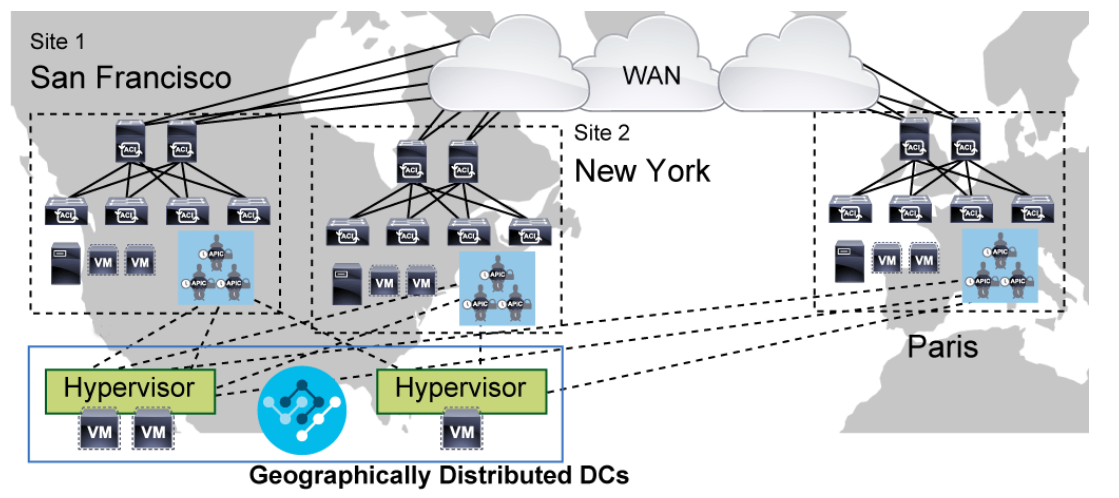EMAIL SUPPORT
dclessons@dclessons.comLOCATION
USCisco Nexus Dashboard Orchestrator (NDO)
Cisco NDO enables you to provision, monitor the health status, and manage the full lifecycle of Cisco ACI networking policies and stretched tenant policies across Cisco ACI sites. These policies can be pushed to the different Cisco APIC domains for rendering them on the physical switches building those fabrics.
Cisco NDO Deployment
You must deploy the Cisco NDO as an application in Cisco Nexus Dashboard.
Cisco Nexus Dashboard is a central management console for multiple data center sites and a common platform for hosting Cisco data center applications, such as the Nexus Dashboard Orchestrator or Nexus Insights.
While Release 3.2(1) supported only the physical form factor of Nexus Dashboard, Release 3.3(1) and later can be deployed in physical, virtual (VMware ESX), or cloud (Amazon Web Services or Microsoft Azure) Nexus Dashboard clusters.
Each Nexus Dashboard cluster consists of 3 master nodes. For physical Nexus Dashboard clusters, you can also provision up to 4 worker nodes to enable horizontal scaling and up to 2 standby nodes for easy cluster recovery in case of a master node failure. For virtual and cloud clusters, only the base 3-node cluster is supported.
A stable connection must exist between the Cisco ACI MultiSite cluster nodes when they are deployed over a WAN.
You should apply the appropriate quality of service (QoS) policy and mark the differentiated services code point (DSCP) value of the node traffic (for example, as Expedited Forwarding [EF]) for proper traffic treatment. The supported round-trip time (RTT) latency between ND nodes is up to 150 msec, which you should take into account when splitting the nodes in different sites. The maximum distance from a Cisco ND cluster to a Cisco ACI fabric site can be up to 500 milliseconds RTT.
There are two main scenarios for the deployment of Cisco ND, which depend on the Cisco ACI MultiSite deployment use cases:
Centralized (local) data center: Requires the creation of separate availability zones in the same data center, usually in the same building or campus, which enables ultra-high port count for bare-metal server, virtual machine, or container connectivity.

Geographically distributed data centers: As a best practice, you should always deploy the nodes in the MultiSite cluster as part of the same geographical region (United States, Europe, Asia, and so on), even when managing Cisco ACI fabrics that span the world.
 Cisco NDO Functions
Cisco NDO Functions
Cisco NDO provides these main functions:
-
Use the dashboard to monitor the health, faults, and intersite policies for all the Cisco ACI fabrics interconnected in the Cisco MultiSite architecture. The health-score information is retrieved from each APIC cluster domain and presented in a unified way.
-
You add a Cisco APIC or Cloud APIC site using the Nexus Dashboard GUI and then enable that site to be managed by Nexus Dashboard Orchestrator.
-
Provision day-0 infrastructure to establish intersite MP-BGP EVPN between the spine switches at all Cisco ACI sites to peer and connect with each other. ISN devices are not configured by the NDO and the user needs to ensure OSPF towards spine switches and IP connectivity across sites are deployed correctly on ISN devices.
-
Create new tenants and deploy them in all the connected sites (or a subset of them).
-
Define policy templates via Schema. Each template can be associated with and pushed to a specific set of fabrics (sites).
-
Import tenant policies from an already deployed Cisco ACI fabric and stretch them to another, newly deployed site.
Cisco NDO is not responsible for configuring Cisco ACI site-local policies, which allows you to perform similar activities through the Cisco APIC cluster at each site. The NDO can import the relevant Cisco APIC cluster site-local policies and associate them with stretched objects. For example, you can import site-locally defined virtual machine manager (VMM) domains and associate them with stretched EPGs.





LEAVE A COMMENT
Please login here to comment.